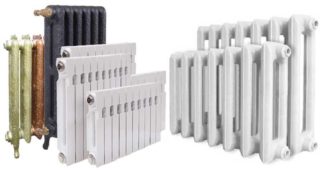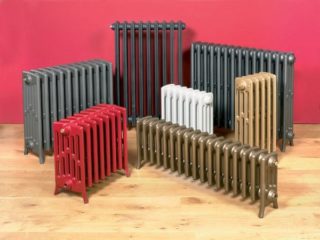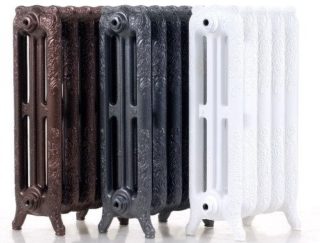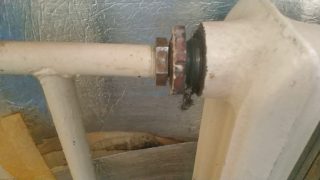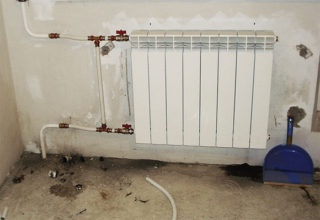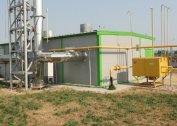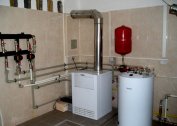Central heating systems are exposed to corrosion and pressure drops. The most efficient radiators that can withstand such conditions are made of cast iron and metal.
Comparison of the characteristics of cast iron and bimetallic batteries
Cast iron heaters are classic models. They have been used for many decades.
Bimetal radiators appeared on the market not so long ago. They are distinguished by a high level of efficiency and good technical characteristics.
When choosing an important role is played by the service life and price category of the product. Knowing the features of each type helps to compare designs and make the choice in favor of the best option.
Construction and appearance
Modern cast iron batteries have a new design. Radiators from foreign manufacturers are represented on the market. The surface of the products is covered with injection patterns. Such models are suitable for modern repairs.
Cast iron batteries are made up of monolithic sections, between which rubber gaskets are laid for tightness. The radiator can be modified by removing the extra section or adding a new one. The length of the device depends on the number of sections. The height is 0.35-1.5 m, and the depth is 0.5 m.
Gradual heating is inherent in cast iron, so a large amount of hot water is required. This explains the breadth of the channels of the structure. Unlike other types, each section of the cast-iron radiator includes two parallel compartments, which ensures high heat transfer.
In some heating devices, feathers are installed between the channels. They provide a high level of heating due to convection. The efficiency level of such batteries is 5-10% higher than that of the base model.
The base of the bimetallic models is made of aluminum. Radiators have a ribbed shape that contributes to optimal heat transfer. A solid steel core is located under the body. Alloy provides the device with a high level of reliability. Bimetal structures include sections. There are monolithic designs. The design of bimetallic products is attractive.
Heat dissipation
To choose cast iron or bimetal for central heating, you need to take into account their ability to give off heat. The heat transfer of devices made of cast iron is characterized by a high level of inertia. Cast iron takes a long time to warm up, so the room does not immediately become warm. Cooling down of a heated radiator takes a long time, which is an advantage in accidents.
The functionality of cast-iron models is based on convection and infrared radiation. There is a warming up of air and objects located in the room. The average heat transfer is 100-160 watts, but deviations are noted in some radiators.
Bimetallic models have a low degree of inertia. This ensures quick warming up of the room. When the heat supply stops, the radiator cools just as quickly. The heat transfer rate of the device section is 150-180 watts. It is close to the markers of cast iron products, so it is difficult to clearly determine which radiators are better, cast iron or bimetallic.
Ability to hold pressure
The pressure in houses with a large number of floors is not stable. The circulation pumps must be smoothly driven, but the condition is not always met. When the flow of hot water stops, the pressure in the system rises to such high levels that the batteries begin to burst. It is recommended that you opt for models with good pressure performance.
Cast iron radiators withstand 9-12 atmospheres. This is a low rate with water hammer. Bimetallic models withstand up to 20-50 atmospheres. Powerful water hammer do not violate the structural integrity of this type of radiator. Steel core models withstand up to 100 atmospheres.
Changing cast-iron batteries to modern ones is recommended in multi-storey buildings.
Maximum coolant temperature
Fluid temperature is unstable. Cast iron batteries can heat up to 110 degrees. Hot water passing through bimetallic models is heated to 130 degrees. Both types tolerate differences.
Due to the difference in expansion of steel and aluminum, bimetallic batteries sometimes crack when the temperature changes.
Durability
Cast iron products last up to 50 years. Some old houses have preserved models that are over 100 years old. The warranty period for bimetallic structures is 15-30 years.
Dismantling old and installing new radiators
Battery replacement is carried out after the end of the heating season. In the same period, preventive measures are carried out. The utility should be notified of the removal of the batteries so that they do not allow water to enter the system or drain it from the circuits. The tightness of the connection is provided by two nuts. One is used to connect the pipe to the battery, and the other is a lock nut.
When dismantling, the following sequence should be followed:
- A nut with a small diameter is turned off for the entire length of the thread of the drive.
- The nut connecting the pipe to the battery is loosened.
- The radiator is removed.
Cast iron batteries are very heavy. Sometimes they have to be cut into several parts. Although the water is drained from the riser, it may remain in the radiator. A rag and bucket should be prepared in advance. Otherwise, the flooring may be damaged.
The main problem when dismantling cast iron products is that the nut may not loosen. In this case, you need to warm up the junction with a blowtorch. The second way is to use a grinder.
Before starting the installation of cast iron products, you should determine the place of installation. The site with the maximum heat loss is selected. Typically, batteries are installed near windows or the front door. In the kitchen they are placed under the windowsill.
During installation should:
- clearly define the middle of the window opening and mark points on both sides for installing fasteners;
- position the radiator at a height of 8-14 cm from the floor;
- maintain the distance between the windowsill and the heating device in 10-12 cm;
- leave a gap of at least 3 cm between the radiator and the wall.
Installation depends on the material of the walls. They must be even and clean. If mounting is made on a wooden surface, a special stand is built. The brick surface involves mounting brackets in a niche. For the wall of drywall, an integral support is being prepared.
Dismantling of bimetallic structures involves draining water from the heating system and unscrewing the device from the pipe. To change the battery, they often resort to overlapping a pipe that is suitable for the radiator. Each battery has a special valve to drain the water. The radiator is unscrewed by means of a gas key.
Before installation, bimetallic models are cleaned with alkali-free detergents. Screw connections are not stripped. When installing, multiple threads are used. Threaded elements are mounted with a force of not more than 12 kg.
Installation involves the following sequence:
- Marked places for brackets. This takes into account the location of the pipes and the design features of the radiator.
- A level is used that eliminates skewing.
- The indicators of the minimum distance of radiators from walls and floor are taken into account.
- The battery is hung on the brackets.
- The device connects to the pipes.
- A valve is installed to release air.
Bimetallic radiators are quite light, as they mainly consist of aluminum. If you know the installation rules, they can be strengthened on a plasterboard partition.
Recommendations for choosing batteries for heating
The choice of cast iron or bimetal radiators depends on the type of building and interior. In old low-rise buildings, Khrushchev, it is recommended to install cast iron products. In the absence of exposure to powerful hydraulic shocks, the system pressure of the device is maintained.
If the apartment is in a house with a large number of floors, the working pressure marker in the coolant will be higher. It is recommended to resort to the installation of bimetallic structures with a high resource. Changing cast iron batteries to bimetallic should be in the presence of an autonomous heating system.
